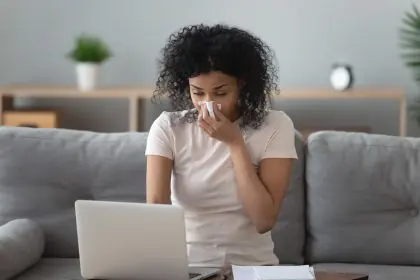Seasonal changes bring unwelcome fungal challenges for millions of women, but scientific approaches offer relief
As spring unfolds across the country, many women experience a familiar discomfort that arrives alongside warmer temperatures. The seasonal shift brings more than just blooming flowers and longer days—it often heralds an unwelcome increase in vaginal yeast infections. This common health issue affects approximately three-quarters of women at some point in their lives, with particular prevalence during warmer months.
The connection between rising temperatures and increased fungal activity isn’t coincidental. Medical experts have identified clear relationships between seasonal factors and the body’s microbiome balance, particularly regarding the fungus responsible for these uncomfortable infections.
The science behind seasonal yeast overgrowth
Understanding the fungal balance
The human body maintains a complex ecosystem of microorganisms, including the fungus Candida. Normally, this organism exists in harmony with beneficial bacteria that keep its growth in check. However, certain conditions can disrupt this delicate balance, allowing Candida to multiply rapidly and cause symptoms.
Research from the National Institutes of Health indicates that environmental factors significantly influence this microbial equilibrium. When temperatures climb and humidity levels rise during spring and summer months, the body’s natural response includes increased perspiration and moisture retention, particularly in areas with limited airflow.
Environmental triggers
Spring creates a perfect storm of conditions favorable to fungal overgrowth. Higher temperatures combined with increased humidity create warm, moist environments where Candida thrives. Additionally, seasonal activities often involve prolonged exposure to wet conditions, such as swimming, which can further exacerbate the problem.
A recent epidemiological study published in the Journal of Women’s Health found that reported cases of vaginal yeast infections increase by approximately 18% during late spring and early summer compared to winter months. This data supports what many women experience anecdotally—a clear seasonal pattern to these infections.
Recognizing the symptoms
Early warning signs
Identifying a yeast infection promptly can help manage discomfort and prevent more serious complications. The most common indicators include persistent itching and irritation in the vaginal area, often accompanied by unusual discharge with a thick, white consistency resembling cottage cheese. Many women also report a burning sensation, particularly during urination or intercourse.
Unlike some other vaginal conditions, yeast infections typically don’t produce a strong odor, which can help distinguish them from bacterial vaginosis or other infections. However, symptoms can vary in intensity and combination from person to person.
When to seek medical attention
While mild yeast infections sometimes resolve without intervention, persistent or severe symptoms warrant professional assessment. Health professionals recommend consulting a healthcare provider if symptoms don’t improve after a few days of home treatment, if infections recur frequently, or if there’s uncertainty about the diagnosis.
Medical evaluation becomes particularly important for women experiencing their first suspected yeast infection, those who are pregnant, or individuals with compromised immune systems.
Prevention strategies for warmer weather
Wardrobe considerations
Clothing choices significantly impact the likelihood of developing yeast infections during spring and summer. Tight-fitting garments, especially those made from synthetic materials, trap heat and moisture against the body, creating ideal conditions for fungal growth.
Fashion experts and medical professionals alike recommend loose-fitting clothing made from natural, breathable fabrics like cotton and linen during warmer months. These materials allow better airflow and help wick moisture away from the body. When selecting underwear, cotton options generally provide better ventilation than synthetic alternatives.
For athletic activities that inevitably lead to perspiration, moisture-wicking performance fabrics can help keep sensitive areas drier. Changing out of damp workout clothes or swimwear promptly after use also reduces infection risk.
Hygiene adaptations
Spring and summer often bring increased physical activity and perspiration, necessitating adjustments to personal hygiene routines. While maintaining cleanliness is important, overwashing can disrupt the vaginal microbiome’s natural balance.
Dermatologists and gynecologists recommend gentle cleansing with mild, unscented soap and water, avoiding harsh products containing fragrances or antibacterial agents that can eliminate beneficial bacteria. After swimming in pools or natural bodies of water, rinsing off chlorine or other potential irritants promptly helps maintain healthy bacterial balance.
Dietary influences
Nutrition plays a surprisingly significant role in managing yeast overgrowth. Research indicates that high sugar consumption can fuel Candida growth, while certain foods help maintain microbial balance.
Nutritionists often recommend reducing refined carbohydrates and sugary foods during infection-prone periods. Instead, incorporating probiotic-rich foods like yogurt containing active cultures, kefir, and fermented vegetables helps replenish beneficial bacteria that keep yeast in check.
Advanced prevention methods
Immune system support
The body’s immune response significantly influences susceptibility to fungal overgrowth. Seasonal allergies, common during spring, can temporarily compromise immune function, potentially contributing to increased infection risk.
Immunologists recommend focusing on immune-supporting nutrients during these vulnerable periods. Foods rich in vitamin C, zinc, and vitamin D help maintain robust immune function. Regular physical activity, adequate sleep, and stress management techniques also contribute to overall immune resilience.
Probiotic approaches
Emerging research supports the use of probiotics both as preventive measures and complementary treatments for yeast infections. These beneficial microorganisms help restore and maintain the vaginal microbiome’s natural balance.
A comprehensive review published in the Journal of Lower Genital Tract Disease analyzed multiple clinical trials and found that certain Lactobacillus strains significantly reduced recurrence rates of vaginal yeast infections when taken regularly. These probiotics work by producing compounds that inhibit Candida growth while maintaining appropriate vaginal pH levels.
Environmental modifications
Home environments can inadvertently contribute to conditions favorable for yeast overgrowth. Excess humidity, particularly in bathrooms and bedrooms, creates microclimates that support fungal proliferation.
Environmental health specialists recommend maintaining indoor humidity levels between 30-50% using dehumidifiers when necessary. Ensuring adequate ventilation in bathrooms after showering and laundry areas helps reduce ambient moisture. For bedding and intimate apparel, high-temperature washing eliminates residual fungi and allergens that might contribute to recurrent infections.
Treatment approaches for established infections
Over-the-counter options
When prevention efforts fall short, various treatment options exist. Pharmacies offer numerous antifungal preparations specifically formulated for vaginal yeast infections, available without prescription. These typically contain active ingredients like miconazole, clotrimazole, or tioconazole.
Pharmacists note that these medications come in various formulations—creams, suppositories, and oral tablets—each with different application schedules and duration of treatment. Following package instructions precisely improves efficacy and reduces recurrence risk.
Natural alternatives
For those preferring more natural approaches, several evidence-supported options exist. Tea tree oil, when properly diluted, demonstrates antifungal properties in laboratory studies. Similarly, boric acid suppositories show effectiveness for some recurrent infections resistant to conventional treatments.
Integrative medicine practitioners often recommend dietary adjustments alongside topical treatments, particularly temporary elimination of refined sugars and alcohol, which can feed yeast growth. However, they emphasize that natural treatments may work more slowly than pharmaceutical options and should be approached with appropriate expectations.
Long-term management strategies
Women experiencing recurrent infections benefit from comprehensive management strategies extending beyond acute treatment. Identifying personal triggers, whether environmental, dietary, or related to specific activities, allows for targeted preventive measures.
Some healthcare providers recommend prophylactic approaches during high-risk seasons, including maintenance doses of probiotics or periodic use of antifungal preparations before symptoms appear. These strategies prove particularly valuable for women with established patterns of seasonal recurrence.
The relationship between seasonal changes and vaginal health represents an important yet underaddressed aspect of women’s wellbeing. By understanding the scientific basis for increased infection risk during warmer months and implementing appropriate preventive measures, women can navigate seasonal transitions with greater comfort and confidence.
As with many health conditions, awareness and proactive management remain the most effective tools against seasonal yeast infections, allowing women to fully enjoy spring and summer activities without unnecessary discomfort.














